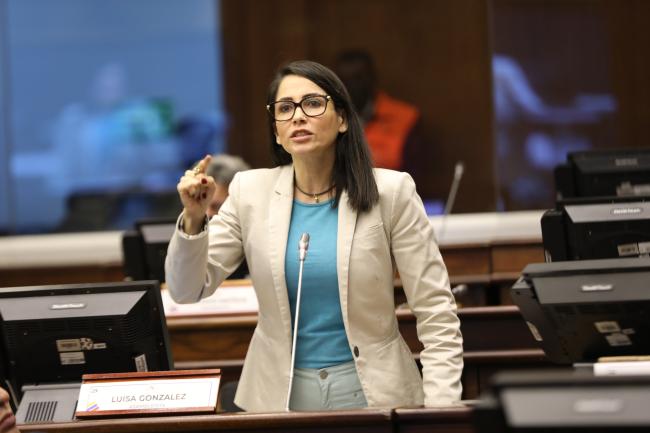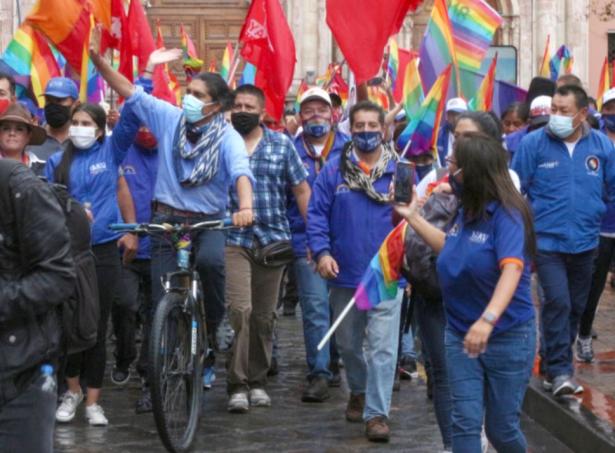Known commonly as “muerte cruzada” or “mutual death,” the innovative provision in the 2008 constitution allows the president to dissolve parliament and rule by decree for six months until new presidential and legislative elections are held. Those who win those elections then serve the remainder of the terms in office until the next regularly scheduled elections. In this case, that is until May 2025—almost two years off.
The Candidates
Well before Lasso triggered new elections, candidates were already lining up to vie for office on the assumption that this might be how his exit from government would unfold. Eight candidates registered for the presidential race by the deadline of June 13.
Former president Rafael Correa’s progressive Revolución Ciudadana party out-performed expectations in the February 2023 mid-term elections, leaving many to assume this slate was best positioned to win in the new contest. Revolución Ciudadana selected the former congressional deputy Luisa González as its presidential candidate. Andrés Arauz, who came in second place in the 2021 elections, will be her running mate.
Ecuador’s electoral law stipulates gender parity, in which electoral slates must be equally divided between men and women. González is not very well known, but she is thought to be close and loyal to Correa and, like the former president, leans left on economic issues but right on social issues.
The environmental activist Yaku Pérez, who placed third in the 2021 elections, will run again, this time as part of a coalition called “Claro Que Se Puede” (Of Course You Can). The academic Nory Pineda, a native of Yaguachi on the coast and vice-rector of Ecotec University, is his running mate.
Pérez is sponsored by the Partido Socialista Ecuatoriano (PSE, Ecuadorian Socialist Party), Unidad Popular (Popular Unity), and Democracia Sí (Democracy Yes), a political movement that former Correa ally Gustavo Larrea formed in 2015.
Pérez ran in the 2021 presidential campaign under the banner of the Indigenous-aligned Pachakutik movement and performed surprisingly well. He garnered 20 percent of the vote, 10 more than any previous Indigenous candidate for the presidency. That performance suggests that he will do well in this upcoming election.

Ecuador’s political left and Indigenous social movements are deeply divided, a result of tensions that emerged during Correa’s first presidential campaign in 2007 that are unlikely to ever be bridged. Their preoccupation with battling another—rather than uniting around a common enemy found in neoliberal economic policies—is what opened the path for Lasso’s election in 2021.
That divide now runs through Pachakutik. A leftwing faction wanted to run Leonidas Iza Salazar, the president of the powerful Indigenous social movement Confederación de Nacionalidades Indígenas del Ecuador (CONAIE, Confederation of Indigenous Nationalities of Ecuador). Iza led sustained protests against Lasso’s neoliberal policies in June of 2022 that almost removed him from office.
This year, Iza insisted on the expulsion of those assembly members from Pachakutik who did not support the impeachment trial against Lasso as a condition for being a candidate. He also demanded the recognition of Guillermo Churuchumbi as the coordinator of Pachakutik. Iza withdrew his candidacy when his demands were not met. Subsequently, Pachakutik announced that it would not present any candidate.
Meanwhile, a faction of Pachakutik aligned with the former CONAIE president and former Pachakutik coordinator Marlon Santi announced its support for Pérez. That faction accuses Iza’s allies of being too willing to collaborate with Correa, whereas Pérez’s opponents charge that he is too friendly to neoliberal and imperial interests.
In an effort to distance himself from both Correa and Lasso, Pérez’s campaign pledges a “third way.” The divides within Pachakutik and between Pachakutik and the broader left pose the danger of once again opening a path for a rightwing candidate with minority support to win the elections.
The most viable rightwing candidate is the economist Jan Topic, a millennial business owner associated with the security sector who some have compared to El Salvador’s president Nayib Bukele. Topic has bragged of being a mercenary in Ukraine and other military conflicts. The traditional rightwing Partido Social Cristiano (PSC, Social Christian Party) is backing Topic.
Other parties, including Lasso’s CREO (Creando Oportunidades, Creating Opportunities) decided not to run candidates for either the presidency or the assembly. Lasso could have competed in the elections but wisely decided not to do so.
Muerte Cruzada
Lasso’s use of the muerte cruzada provision was controversial because it was designed to resolve problems in instances of legislative deadlock, not to bail out the political fortunes of a deeply unpopular president.
After campaigning for the top office for twenty years, Lasso proved incapable of implementing his rightwing neoliberal agenda once assuming the presidency. He has very little to show for his two years in office other than cuts in funding for social investments, including for education, health, and basic services.
The impeachment charges that Lasso faced revolved around allegations of corruption that Lasso naturally denied. Underlying them was a growing sense of insecurity among the general populace due to skyrocketing homicide and other crime rates as powerful narco-trafficking groups fought for control of territory.
During Lasso’s time in office, Ecuador has experienced the highest inflation rates of the decade, the highest rate of homicide in decades, mass out-migration, and unprecedented drug-related activities.
For the social movement left, more concerning was Lasso’s trampling on labor rights and the criminalization of protest. He engaged in repressive responses to sustained demonstrations against his neoliberal economic policies that delivered high taxes for most of the population and privileges for bankers like himself and his corporate cronies.
Lasso’s government fostered hate, racism, and discrimination. Support for his leadership has been further eroded by rampant destruction of the environment with his prioritization of petroleum and mining extraction.
Social movements are now carefully watching if Lasso will attempt to push through parts of his rightwing agenda by executive decree during his remaining months in office. If he tries to implement what he was unable to accomplish through the legislative process he will face strong pushback.
The elections are scheduled for August 20. Ecuadorians will also be voting on whether to prohibit petroleum exploitation in the ecologically sensitive Yasuní National Park. Residents of the Metropolitan District of Quito will also cast ballots on whether to ban metallic mining.
Under Ecuador’s electoral law, a presidential candidate must win either a majority of the vote, or at least 40 percent of the vote with a 10-point margin over the nearest competitor. Otherwise, a run-off election between the top two candidates will be held on October 15.
The victors will assume their posts on November 25, and serve through what would normally have been the end of Lasso’s term on May 24, 2025.
The ramifications of the outcome will extend well beyond that truncated term and the borders of Ecuador; a regional migration crisis and the proliferation of criminal activity could destabilize the wider region. With a recent regional turn to the left, Lasso was the Biden administration’s closest remaining ally in Latin America. A big question is whether that will continue to be the case with a new administration.
Voters are faced with essentially three distinct paths: a return to the neo-Keynesian policies of Correa’s 2007–2017 administration that significantly reduced poverty and wealth inequality but trampled dissent, represented by González and Revolución Ciudadana; a continuation of Lasso’s neoliberal policies that have harmed the poor and increased insecurity, embodied by Topic; or a turn to Pérez’s Indigenous environmentalism.
Will Ecuador remain in the orbit of the United States, join a regional turn to the left, or chart a new and largely unknown path? In a heavily divided and unstable landscape, the outcome is uncertain.
[Marc Becker is the author among other works of Indians and Leftists in the Making of Ecuador's Modern Indigenous Movements (2008) and Pachakutik: Indigenous movements and electoral politics in Ecuador (2011). He is currently writing a book on Philip Agee and the CIA in Ecuador in the early 1960s.]
Thanks to the author for sending this to Portside.


Spread the word